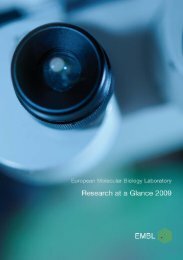New heads of units for EMBL Heidelberg Council ... - EMBL Grenoble
New heads of units for EMBL Heidelberg Council ... - EMBL Grenoble
New heads of units for EMBL Heidelberg Council ... - EMBL Grenoble
Create successful ePaper yourself
Turn your PDF publications into a flip-book with our unique Google optimized e-Paper software.
<strong>EMBL</strong>&cetera • August 2007 • page 7“Rein<strong>for</strong>cing<strong>EMBL</strong>’s footprint onthe chemicalbiology map”Researchers at <strong>EMBL</strong> have just started thefirst phase <strong>of</strong> a three-year initiative aimedat translating basic research into new anti-cancerdrugs and transferring technology from<strong>EMBL</strong> into a new start-up company.A Go-Bio/BioChance Plus award <strong>of</strong> €3.4mfrom the BMBF will focus on translationalresearch and is coordinated by Joe Lewis, head<strong>of</strong> the Chemical Biology Core Facility, who issupported by George Reid <strong>of</strong> the FrankGannon Group in <strong>Heidelberg</strong>. This grantenables basic biologists, medicinal chemistsand computational chemists to pursue leadsthat have promise as anti-cancer drugs and toenhance the expertise that is currently inhouse.The most promising series <strong>of</strong> small moleculeswill be tested <strong>for</strong> efficacy in vivo usingmodels <strong>of</strong> different tumours, such asleukeamias, lung cancer and breast cancer.This project-driven research will integratechemistry into biology and raise the pr<strong>of</strong>ile <strong>of</strong><strong>EMBL</strong> in its chemical biology ef<strong>for</strong>ts.The project depends on industry experiencedtalent; Jochen Ammen has just beenhired from a large pharmaceutical company tolead a team <strong>of</strong> medicinal chemists who areworking in labs temporarily rented from BASFin Ludwigshafen. They have just started tosynthesise the first variations <strong>of</strong> compoundsidentified in the <strong>EMBL</strong> Chemical Biology CoreFacility from screens inspired by the basicresearch <strong>of</strong> the Gannon and Conti laboratories.The Go-Bio project pursues two differentavenues: one is to inhibit Aurora kinases, a keyplayer in many tumours, through a novelallosteric binding site. The details <strong>of</strong> this siteOne <strong>of</strong> <strong>EMBL</strong>’s current aims is to expandfurther into the growing field <strong>of</strong> chemicalbiology. Here’s how we’re doing it...were uncovered by Elena Conti’s group andIsabelle Vernos’ group at <strong>EMBL</strong> <strong>Heidelberg</strong>.The other projects under development arisefrom ground-breaking discoveries by theGannon group in transcriptional cycling. Thecomplexity <strong>of</strong> these events suggested that it maybe possible to modulate estrogen signalling, akey factor in the development <strong>of</strong> breast cancer,not only with small molecules that directly interactwith ER-α, but also with small moleculesthat target other processes involved in transcription.Not all <strong>of</strong> this project will be done at <strong>EMBL</strong>:after an initial period <strong>of</strong> one year, part <strong>of</strong> theBMBF funding and the staff will be transferredto ELARA Pharmaceutical GmbH, a start-upcompany that was founded by Joe, George,Frank Gannon and others last year, <strong>for</strong> furtherdevelopment.<strong>EMBL</strong> <strong>Heidelberg</strong> will eventually have a dedicatedchemistry infrastructure to reflect thegrowing importance <strong>of</strong> the field in molecularbiology.“Small molecule screening has lately movedaway from pharma and industry into academiclabs,” explains Joe. “Its methods are becomingmore amenable to basic research groups, and sochemical biology is becoming increasinglyimportant to the work done at <strong>EMBL</strong>. With this,the Go-Bio project will be a great demonstrationthat basic research can address the expectation<strong>of</strong> society that new medicines can and will bedeveloped from basic biology.”“Through creating a project-led, seamlessflow from basic research through preclinicaldevelopment, we will increase the opportunities<strong>for</strong> drugable targets and <strong>of</strong>fer greater prospects<strong>for</strong> the treatment <strong>of</strong> cancer,” says George.<strong>New</strong> participant in joint chemical biology core facility<strong>Heidelberg</strong> University is set to join theDKFZ/<strong>EMBL</strong> Chemical Biology CoreFacility, resulting in an even better serviceto help scientists develop new researchtools.The three-and-a-half-year old facility,based at <strong>EMBL</strong>, <strong>of</strong>fers researchers the abilityto screen small molecules and identifybiological inhibitors and drug precursors.The new set-up will pay <strong>of</strong>f not only by providingexcellent research possibilities butalso by benefitting each <strong>of</strong> the three institutesby attracting scientists and improvingexternal funding <strong>for</strong> medicinal chemistry.“It adds significant value by creating possibilities<strong>for</strong> successful technology transfer or<strong>for</strong> our spin-<strong>of</strong>f companies such as ElaraPharmaceuticals,” commented MartinRaditsch <strong>of</strong> <strong>EMBL</strong>EM, the commercial arm<strong>of</strong> <strong>EMBL</strong>.Planting the seedSynergy is a word <strong>of</strong>ten misused in biology.The 20-22 June EMBO workshop at <strong>EMBL</strong>Hamburg, “Integrated Approaches inStructural Enzymology: The Chemistryand Biochemistry <strong>of</strong> Catalysis byBiological Systems”, was excellent pro<strong>of</strong>that true synergy is to be obtained at theinterfaces between scientific disciplines.The workshop, which aimed to give anoverall perspective on current concepts onthe chemistry and biology <strong>of</strong> enzyme function,brought together about 100 crystallographers,NMR specialists, enzymologists,biochemists and computational biologists<strong>for</strong> sessions on drug design, molecularmotors, new technologies, the origin <strong>of</strong> thecatalytic power <strong>of</strong> active sites and the design<strong>of</strong> new biocatalysts. One highlight amongthe exceptional presentations by high-rankingspeakers was Vern Schramm (AlbertEinstein College, NY), who mapped indetail the transition-state structure <strong>of</strong> smallmolecule substrates in enzymatic reactionssuch as <strong>for</strong> the enzyme purine nucleosidephosphorylase. This provides powerfulmechanistic insights into enzymology thatcan be used to aid rational design <strong>of</strong> substratecompetitive inhibitors with very highpotencies. Using this approach, his lab hasdeveloped a new class <strong>of</strong> inhibitors that arecurrently being tested in clinical trialsagainst T-cell malignancies.The response from the participants wasvery positive. Extensive discussions andextremely productive poster sessions complementedthe lectures. The idea <strong>of</strong> integratedmultidisciplinary approaches <strong>for</strong> anin-depth investigation <strong>of</strong> enzymes washighly appreciated by the audience.Specific emphasis was given to the applicationand the use <strong>of</strong> in<strong>for</strong>mation <strong>for</strong> the elucidation<strong>of</strong> structure function relationships.There was general agreement from thecurrent participants that having such aworkshop on a yearly basis could provide aplat<strong>for</strong>m <strong>for</strong> fruitful discussions, networkingand future collaborations and rein<strong>for</strong>ce<strong>EMBL</strong>’s footprint on the chemical biologymap.Organising committee:Andrea Schmidt and Victor Lamzin(<strong>EMBL</strong> Hamburg), Joe Lewis (<strong>EMBL</strong><strong>Heidelberg</strong>), Rikkert Wierenga (Uni. <strong>of</strong>Oulu), Andrea Mattevi (Uni. <strong>of</strong> Pavia),Hartmuth Oschkinat (FMP Berlin)













